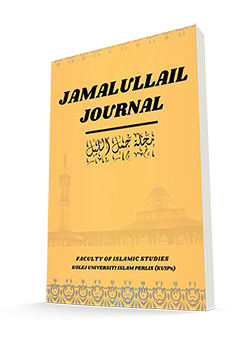Konsep Al-Ta’dīl Al-Dimnī Menurut Al-Ismā’īlī: Analisis Terhadap Karya Al-Mu’jam
The Concept Of Al-Ta’dīl Al-Dimnī According To Al-Ismā’īlī: An Analysis Of His Work Al-Mu’jam
Keywords:
al-ta’dīl al-taşrīhī, al-ta’dīl al-dimnī, Mu'jam al-Syuyūkh, jarh wa ta’dil, hadithAbstract
One of the conditions for the acceptance of hadith is the proven integrity of the narrator, which can be achieved through two methods: explicit characterization of the narrator (al-ta’dīl al-taşrīhī) or implicit characterization (al-ta’dīl al-dimnī). There are many texts from scholars that show their reliance on al-ta’dīl al-dimnī. Al-Ismā’īlī, in his book Mu'jam al-Syuyūkh, uses al-ta’dīl al-dimnī by not commenting on narrators who are considered trustworthy. However, the question arises whether the al-ta’dīl al-dimnī applied by al-Ismā’īlī can be used as a general reference in the evaluation of hadith narrators. This study is important because it helps clarify the effectiveness and reliability of the al-ta’dīl al-dimnī methodology in the evaluation of narrators, which in turn can provide guidance to hadith researchers in more accurately determining the integrity of narrators. Therefore, this study analyzes the narrators who were not commented on by al-Ismā’īlī and compares them with the views of other jarh wa ta’dil scholars. The methodology used in this study is a qualitative approach based on document analysis for data collection and content analysis as the data analysis method. The results of the study found that out of the 19 narrators given al-ta’dīl al-dimnī by al-Ismā’īlī, 10 were classified as rejected (mardūd) while the remaining nine were considered acceptable (maqbul). Suggestions for further research include in-depth analysis of al-Ismā’īlī's methodology in implicit evaluation of narrators and the application of the al-ta’dīl al-dimnī concept in the works of other scholars, as well as expanding the scope of narrators analyzed to obtain a more comprehensive picture.
Downloads
References
Abdul Aziz Bin Abdul Latif. (2017). Dhawābit al Jarh wa Ta’dīl (Cetakan ke-6). Madinah: Dār Tayyibah al Khudarā’.
Abdullah bin Ahmad. (1994). Su’ālāt Abū Dāwud li al-Imām Ahmad. Madinah: Maktabah al-‘Ulūm wa al-Hikam.
Abū Bakr al-Ismā’īlī. (1990). Kitāb al-Mu’jam fī Usāmī Syuyūkh Abī Bakr al-Ismā’īlī. Madinah: Maktabah al-‘Ulūm wa al-Hikam.
Al-Jauharī, I. H. (1987). Al-Şihāh Tāj al-Lughah wa Şihāh al-‘Arabiyyah. Beirut: Dār al-‘Ilm lil al-Malāyyīn.
Al-Juwainī, A. M. A. (1997). Al-Burhān fī Uşūl al-Fiqh. Beirut: Dār al-Kutub al-‘Ilmiyah.
Al-Khalīlī, K. A. (1989). Al-Irsyād fī Ma’rifah ‘Ulamā al-Hadīth. Riyadh: Maktabah al-Rusyd.
Al-Munawi, M. A. (1999). Al-Yawaqit wa al-Durar fi Syarah Nukhbah Ibn Hajar. Riyadh: Maktabah al-Rusyd.
Al-Sakhawi, S. M. (1993). Fath al-Mugith Syarah Alfiyyah al-Hadith. Beirut: Dar al-Kutub al-Ilmiyyah.
Al-Sam’ānī, A. K. M. (1982). Al-Ansāb. India: Majlis Dā’irah al-Ma’ārif al-Uthmāniyyah.
Al-Syahrazuri, A. A. (1986). ‘Ulum al-Hadith. Dimasyq: Dar al-Fikr.
Al-Zahabī, M. A. (1985). Siyar A’lām al-Nubalā’. Beirut: Mu’assasah al-Risālah.
Al-Zahabī, M. A. (1998). Tazkirah al-Huffāz. Beirut: Dār al-Kutub al-‘Ilmiyyah.
Al-Zarkalī, K. M. (2002). Al-‘A’lām. Beirut: Dār al-‘Ilm li al-Malāyyīn.
Dzulraidi, D. H., Mohd Ithnin, N. K., Amat Famsir @ Amat Tamsir, M. T., & Ayub, D. H. (2024). Konsep Qarā’in Al-Tarjīḥ dalam Pensabitan Samāʿ: Kajian Terhadap Muqarrar Al-Takhrīj Karya Ḥātim Al-ʿAwnī: The Concept of Qarā’in Al-Tarjīḥ in Authenticating Samāʿ: A Study on Muqarrar Al-Takhrīj by Ḥātim Al-‘Awnī. Journal of Ifta and Islamic Heritage, 3(1), 169–196. https://ejournal.muftiwp.gov.my/index.php/jiftah/article/view/67
Hamzah Yūsof al-Sahmī. (1987). Tārikh Jurjān. Beirut: ‘Ālam al-Kutub.
Ibn al-Athīr, M. M. (1979). Al-Nihāyah fī Gharīb al-Hadīth wa al-Athar. Beirut: al-Maktabah al-‘Ilmiyyah.
Ibn Hajar al-‘Asqallānī. (2008). Lisān al-Mīzān. Beirut: Maktabah Beirūt.
Imān Rajab Hamdān. (2024). Al-Tausīq al-Dimnī wa Atharuhu fī Ta’dīl al-Ruwāh. Azhar: Dār al-Zakhāir.
Māzin bin Abdul Rahman. (2006). Tārikh Naysābur. Beirut: Dār al-Basyāir al-Islāmiyyah.
Mohd Awang Idris, Haslina Muhamad, & Zirwatul Aida R. Ibrahim. (2018). Metodologi Penyelidikan Sains Sosial. Kuala Lumpur: Penerbit Universiti Malaya.
Muhammad Bin ‘Alawi. (2003). Al-Qawā’id al-Asāsiyah fī Ilm Muştalah al-Hadīth. Kaherah: Dār al-Hāwi.
Muhammad Bin Muhammad Bin Sulaim. (2010). Al-Wasīth fī Ulūmi wa Mustalah al Hadīth. Dār Fikr al ‘Arabī.
Muhammad Bin Mukrim. (1994). Lisān al ‘Arab. Beirut: Dār al Šadir.
Muhammad Bin Sulaimān. (1986). Al-Mukhtasar fi ‘Ilmi al Rijāl. Maktabah al Rusyd.
Muhammad Murtadha al Husaini. (2001). Tāj al-‘Arūs. Dār Ihyā’ al Turāth.
Muslim Bin al Hajjāj. (1955). Sahih Muslim. Kaherah: Matba’ah Īsa al Bābī.
Samer Usāmah Ibrāhīm. (2019). Al-Imām Abū Bakr al-Ismā’īlī wa Manhajuhu fī al-Jarh wa al-Ta’dīl (Disertasi Sarjana, Universiti Gaza).
Solāh Ahmad Muhammad Isa. (2018). Al-Ta’dīl al-Dimnī ‘inda al-Muhaddithīn wa al-Uşūliyyīn. Majallah Kuliyyah Uşūl al-Dīn wa al-Da’wah, 38(1).
Syarīf Hātim al-‘Awnī. (2002). Khulāsah al-Ta’sīl li ‘Ilmi al-Jarh wa al-Ta’dīl. Mekah: Dār ‘Ālim al-Fawāid.
Downloads
Published
How to Cite
Issue
Section
License
Copyright (c) 2024 DZULFAIDHI DZULRAIDI

This work is licensed under a Creative Commons Attribution 4.0 International License.





